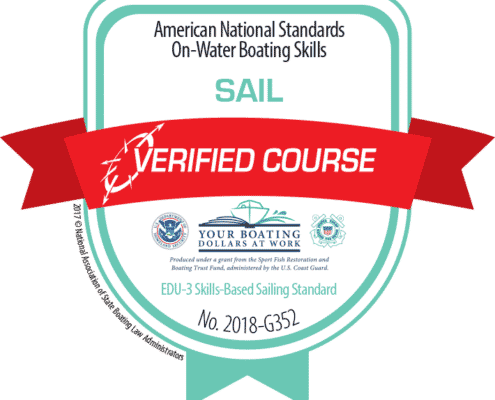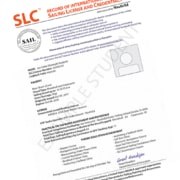Sailing Instruction and Assessment Standards USCG
NauticEd Embraces New Sailing Training Standards in the USA and is Officially Recognized by the US Coast Guard and by NASBLA
In 2016, the United States Coast Guard (USCG) funded a study on how to further safety standards for boating. The result for sailing was a coming together of many industry leaders to create a comprehensive standard for ensuring the competence of an entry-level sailor using the well-established teaching and assessing methodology – Rubrics.
The standard was reviewed and approved by the American National Standards Institute (ANSI) which is a member organization of the International Standards Organization (ISO); this is a big deal.
NASBLA, the overseeing organization for state boating licensing is the official body to review applications and implementation by sailing education bodies and to award adherence and recognition.
In light of this, NauticEd quickly moved to align its training and assessments to meet and exceed the new standard and is officially recognized as such.
- This official verification letter shows that NASBLA recognizes and awards NauticEd as meeting the American National Standards for sailing training and assessment.
- Below is NauticEd’s Badge representing the award.
What is admirable (excuse the pun) about this USCG-funded result is the introduction of rubrics in the assessment of the student process. The following is a write-up for our practical training schools for them to bring on rubrics into their schools and apply to students.
History
The word “rubrics” comes from the 13th century and essentially means “A guide listing specific criteria”. In early printing, it was the Red in a sentence that pointed out the most meaningful words. In modern times, rubrics have taken on an academic sense; it is “A guide listing specific criteria for grading and scoring academic assignments or tasks”.
What are Rubrics?
Simply stated, rubrics are assessment tools. Rubrics specify expectations for a training topic by listing the criteria and then describing associated levels of quality. They work by breaking the whole down into specific tasks and then grading each task on its own to produce a full report. This system allows a consistent objective analysis and justified result of the whole.
Academic Use
Academic institutions have widely adopted rubrics as a way of ensuring students fully understand a skill before the teacher moves onto the next skill. But the use of rubrics is not only for the student’s benefit; it also benefits teachers and institutions by creating consistency in both teaching and grading. Overall, it improves instructor and student performance, provides feedback mechanisms, and promotes general overall professionalism.
The introduction of rubrics in academics was so successful that most every training industry has now adopted this method of instruction and assessment, including the military.
Why Use Rubrics?
The benefits to using rubrics for training are many:
- Improves consistency and quality of grading
- Improves the assessing standard
- Gives expectations of specific performance to the student
- Improves the feedback to the student
- Improves self-evaluation to the student
- Improves directions to the student
- Improves focus for each task
- Improves objectivity in the overall grade
Application to Sailing Training
Sailing instruction, and issuing passing grades and certificates should be no different from any other modern training requirement. Recently, there have been some good moves in this direction.
In 2015, the Canadian Department of Transport adopted rubrics for boating assessments in their desire to increase safety and issue certificates of competence to boaters in their waterways.
In 2016, the United States Coast Guard funded a project to increase the competency of boaters for power, sail and paddle boards. The project resulted in a standard of sailing training and assessments incorporating rubrics as the fundamental manner in which an instructor could determine the competence of a boater. The standard created was approved by ANSI (The American National Standards Institute). The project was released to the public in mid-2017.
NauticEd proudly and fully supports these recent efforts. For too long now, some sailing institutions have diluted proper instruction in favor of an exchange of credit card for a passing certificate. Additionally, there has been too much pressure on instructors to issue the passing grade after weekend training even if there is not a full demonstration of competence. Shortcuts are taken: helping students on tests, skipping critical areas because of time constraints, and passing students despite lack of wind. While some good schools have kept the standards high, across the board, consistency in quality is lacking. For example, yacht charter companies do not trust a sailing certificate issued by some sailing institutions because they cannot guarantee the quality of the certificate; instead, they ask for a documented resume.
For this reason, NauticEd is voluntarily and fully adopting the sailing training and assessment standards created in association with the United States Coast Guard and approved by the American National Standards Institute.
Why the American National Standard?
Whether you know it and no matter where you are, you are most certainly touched by the American National Standards Institute (ANSI). From the strength of steel in a bolt, the amount of copper in a 12 gauge electrical wire, the speed at which your hard drive spins, to the data talk protocol between navigation devices, ANSI plays a role in your life. ANSI is an enormous company that oversees the adherence to consistency by establishing worldwide standards.
As an international sailing education company, NauticEd recognizes other countries may have nationally recognized sailing standards as well. We respect these standards and our software will adjust accordingly in order to issue badges and certificates reflecting your country’s national standards while still applying a rubric methodology of assessment.
We invite sailing schools and sailing instructors to join us. The process is simple and will increase the overall profitability of the school.
How do Sailing Rubrics Work?
Groups & Tasks
For Sailing, the Rubrics Training and Assessment Standard approved by the American National Standards Institute breaks down to 47 tasks under 7 groups.
The groups of tasks are:
- Prepare to Depart
- Leave Point of Departure
- Maneuver Under Sail in Close Quarters
- Operate in Open Water’
- General Safety and Emergency Procedures and Maneuvers
- Arrive at Destination
- Secure the Vessel
Each group contains several specific tasks. For example, Group 4 “Operate in Open Water” contains 15 individual and specific tasks including tack the boat, gybe the boat, and reef the sails.
Having a list of training items or topics is not new to sailing instructors. And most likely, the sailing rubrics do not contain any new topics than what sailing instructors are already teaching. But, rubrics add so much more to training for both the instructor and the student because, at the end of the training and assessment, the instructor and student have a full report on how the student performed in every specific task. A review of the report gives the instructor enough information to make a decision on the overall grade and both the instructor and student are able to see where improvements are needed specific to any tasks.
Grading of Tasks
The grading of tasks is task specific. Each task is graded separately. And the task grade is not just pass-fail but rather an actual grade based on performance.
For example, the sailor is asked to perform a task of tacking the boat. During the task, the instructor assesses Did the sailor correctly turn through the wind to the appropriate heading and manage the sails accordingly while looking out for traffic and managing the crew at the same time? Did the sailor manage this with confidence or did they need direction? Did they turn the boat properly but left the sails untrimmed? Ultimately, did this sailor demonstrate excellence, demonstrate satisfactory competence, need direction, or had poor understanding of what it needs to tack the boat?
Thus, the assessment of each task can be graded as follows:
- Excel: The student excelled at this task and is easily competent to skipper a boat specifically regarding just this task
- Skipper: The student performed this task satisfactorily and is competent to skipper a boat specifically regarding just this task
- Qualified Crew: The student is not able to safely skipper the boat specifically regarding this task without direction. Rather the student would make a good skipper’s assistant – a good crew member.
- Fail: The student had poor understanding and consistently failed at performing this task even as a crew member.
Overall result of the assessment (Summative Evaluation)
The overall assessment of the student is graded as follows:
- Skipper Competence pass;
- Qualified Crew Competence pass; or
- Fail
The instructor has discretion on the overall grade based on the assessment of the performance of the specific tasks and the relative critical or non-critical nature of the tasks.
For example, an instructor may pass a student as Skipper Competent under the following scenario: The student may have demonstrated only crew competence at some tasks but overall the instructor believes those are non-critical. And the student can safely sail a vessel without danger to themselves or others, and the student demonstrated improvement. In this case, under the NauticEd software, an instructor may elect to issue a Skipper Competence with Provisional Restriction; safety is not a concern, but the student needs self-improvement in a few identified tasks.
Or in another case, if too many tasks are marked as Qualified Crew competence then the instructor may issue an overall Qualified Crew competence grade only.
Report
A tangible and comprehensive report is provided to the student following every assessment. This report details all the tasks, the grade received on the task, the overall grade, and identifies the strengths and weaknesses of the student. The student can use this report to support their learning, to identify tasks needing improvement, and to track their overall progress. Most importantly, the report is an honest representation of a student’s ability to safely command a vessel.
Assessment With Out Training
Finally, sailing assessments can be done at any time without training. They can be performed as a completely standalone effort for a student-sailor who self-states that they are competent and are just wanting recognition.
Why Use the National Standard of Sailing Training and Assessment Rubrics?
Objectivity Replaces Pressure
When using a rubric methodology, the decision on whether or not to pass the student overall to Skipper Competence now becomes an objective decision, albeit with instruction discretion, and does not fall to any pressure by the student or school. It is simply a decision based on the overall report as assessed by the instructor.
This empowers the instructor. There is clear evidence as to whether or not a pass for overall Skipper competence should be issued. Thus, the instructor may use objective based discretion to pass the student.
Professional Feedback to the Student
As any professional instructor or teacher, there is a responsibility to give the student the best possible feedback on their skills at the end of the assessment.
A rubrics report helps the student identify their areas of weakness and the areas in which they need to improve prior to being given the command of a vessel.
Feedback is especially important where the instructor either does not give a Skipper Competence pass, or in the case where the instructor uses discretion to pass the student despite some lack of competence in some areas.
Additionally, NauticEd’s instructor dashboard allows for feedback notes to be made to the student. The instructor should use these to reflect rubric tasks needing improvement.
Legal
Rubrics provide an added layer of protection to the instructor and school. A legal battle claiming that the student was not taught a critical skill becomes a non-defensible argument. With the rubrics, there exists clear documented evidence that the student was assessed and passed according to national standards.
Empowerment
Until now in the sailing industry, instructors have been asked to instruct and certify students without a meaningful tool to objectivity assess competence. Now sailing instructors are empowered to train and assess competence to nationally developed sailing standards. The rubrics tool is a nationally recognized standard of assessment that uses an objective and documented means to issue grades upon merit. Instructors are no longer constrained by private associations to issue a “certificate of attendance”.
Professional Advantage
Since the sailing industry is finally focusing on competence, schools and instructors want to stay competitive by using the national standard rubric system.
Instructor Professional Credentials
For instructors using the national standard rubric system, NauticEd will recognize such with a badge on their instructor certificate and an acknowledgment in their NauticEd instructor biography.
Student Demand
Students who are assessed by an instructor adhering to the national standards will have a badge printed on their competence certificate acknowledging such. Potentials students will consequently favor schools that can offer this.
School Marketing
For those schools using the national standard rubric system, NauticEd will recognize such with a badge to be displayed on their website and marketing materials.
Increased School Sales
Schools using the rubric system will increase sales.
- A student is more likely to choose your school over competition if they see the professional approach you take to training and assessment, especially if they see a sample report during the sales process.
- A student is more likely to join your school/club if they feel confident that you teach according to national standards.
- A student who is shown the expectations before hand is more likely to sign up for training.
- A student is more likely to sign up for additional lessons if they truly understand their areas of weakness.
- A student is more likely to sign up for advanced lessons if they feel confident about your school’s professional and accredited teaching standards.
- A student is more likely to choose your school over competition if they see that they will gain a national standards badge on their certificate of competence.







